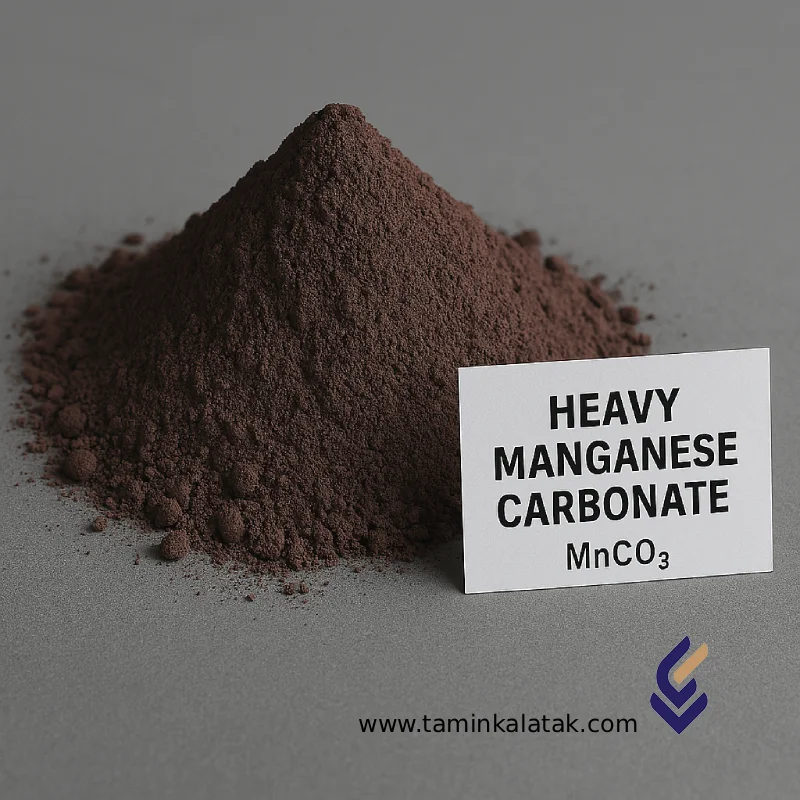Manganese carbonate
Manganese Carbonate (MnCO₃) is a key inorganic compound widely used across various industrial sectors. Naturally occurring as the mineral Rhodochrosite, it appears as a light pink to brown crystalline powder.
It serves as an essential raw material for producing manganese-based chemicals, ceramic pigments, and as a micronutrient source in agriculture.
Tak Supply Co., as a leading supplier of industrial raw materials, proudly offers high-purity Manganese Carbonate tailored to meet the diverse needs of chemical, ceramic, and agricultural industries.
Chemical Structure
Manganese Carbonate is an ionic salt composed of divalent manganese cations (Mn²⁺) and carbonate anions (CO₃²⁻).
It is insoluble in water, but readily decomposes in dilute acids, releasing carbon dioxide — a typical reaction used for its identification.
| Property | Specification |
|---|---|
| Chemical Formula | MnCO₃ |
| Molecular Weight | 114.95 g/mol |
| Appearance | Light pink to brown crystalline powder |
| Density | 3.12 g/cm³ |
| Decomposition Temperature | >200°C (decomposes to MnO + CO₂) |
| Solubility in Water | Practically insoluble |
| Solubility in Acids | Soluble in dilute mineral acids |
| CAS Number | 598-62-9 |
Industrial Applications
1. Agriculture and Fertilizer Production
Used as a micronutrient source of manganese (Mn) — essential for photosynthesis, enzyme activation, and plant growth.
Its slow-release nature makes it suitable for alkaline soils to correct manganese deficiency.
2. Ceramics, Glazes, and Pigments
Functions as a coloring agent, imparting pink, brown, or purple hues to ceramic bodies and glazes.
3. Chemical Manufacturing
A precursor in the production of manganese compounds such as manganese oxide (MnO), manganese sulfate (MnSO₄), and manganese chloride (MnCl₂).
4. Metallurgy and Electronics
Applied in the production of ferrites and magnetic materials for electronic components and as an additive in welding electrode coatings.
5. Animal Feed Additive
Serves as a nutritional supplement to supply manganese in animal feed formulations for livestock and poultry.
Key Advantages
-
Economical source of manganese for industrial and agricultural use.
-
High purity grades available for specialized chemical and electronic applications.
-
Slow and sustained release of Mn in soils, improving nutrient efficiency.
-
Versatile and compatible with multiple industrial processes.
Limitations
-
Air oxidation sensitivity: Prolonged exposure to air and moisture may oxidize MnCO₃ to manganese oxides, affecting color and purity.
-
Insoluble in water: Not suitable for liquid fertilizers or foliar applications; manganese sulfate is preferred in such cases.
-
Dust formation: Powder handling may generate dust; appropriate ventilation and PPE are recommended.
Safety and Storage Guidelines
-
Storage: Keep in cool, dry, and well-ventilated areas, away from strong acids, heat, and moisture.
Store in sealed containers or lined bags to prevent oxidation and moisture absorption. -
Personal Protection: Use dust masks, gloves, and safety goggles to avoid inhalation or contact with eyes and skin.
-
Environmental Precaution: Avoid release into drains or soil; dispose of according to local environmental regulations.
Summary
Manganese Carbonate (MnCO₃) is a versatile and cost-effective raw material essential in chemical synthesis, ceramics, metallurgy, and agriculture.
Its chemical stability, controlled solubility, and micronutrient value make it a preferred material in both industrial and agronomic applications.
Applications
Manganese carbonate
| Solubility in water | melting point | Density (at 20°C) | Physical appearance | Vapor pressure | grade | Chemical formula | Chemical name |
|---|---|---|---|---|---|---|---|
| very slight (almost insoluble) | Decomposes at about 200°C (to MnO + CO₂) | 3.12 g/cm³ | Pale pink to light brown solid powder or crystal | Practically zero in standard conditions | صنعتی، آزمایشگاهی، دارویی و خوراک دام | MnCO₃ | (Manganese(II) carbonate) |







